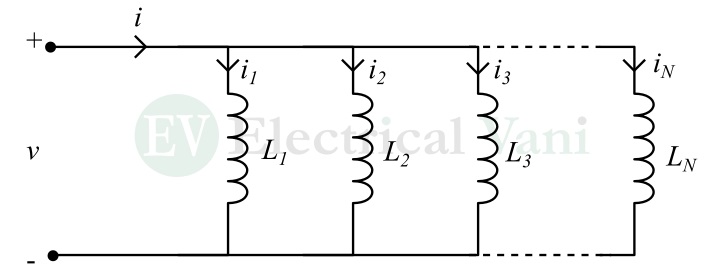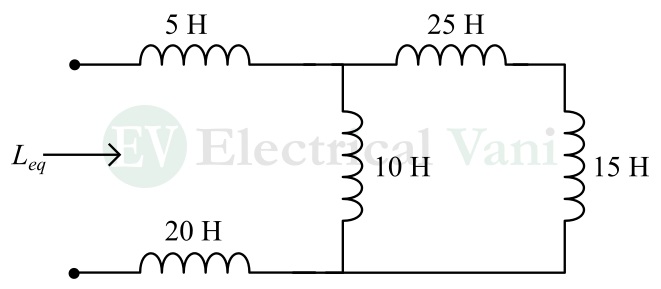In this article, I will explain the series and parallel combination of inductors (i.e., inductors in series and parallel). An inductor is a passive circuit element used in electronics and power systems to store electrical energy in its magnetic field. A conductor wire shaped in a coil is termed as an inductor. To introduce a required value of inductance in an electric circuit, inductors can be combined in series or in parallel. We can replace series-connected or parallel-connected inductors with a single inductor having an equivalent inductance. Let us derive the relation for equivalent inductance for a series combination of inductors and a parallel combination of inductors.

Inductors in Series
When two or more inductors are connected end-to-end in a chain, they are said to be connected in series. The combination of inductors is called a series combination of inductors. Inductors are mainly combined in series to obtain a higher inductance value.
Let us consider a series combination of N inductors as shown in the following figure.

We can see the same current is flowing through all inductors. Applying KVL to the loop, we get,
$$v=v_1+v_2+v_3+⋯+v_N$$
Since, we know, for an inductor, the voltage is given by,
$$v=L \frac{di}{dt}$$
Therefore,
$$L_{eq} \frac{di}{dt}=L_1 \frac{di}{dt}+L_2 \frac{di}{dt}+L_3 \frac{di}{dt}+⋯+L_N \frac{di}{dt}$$
$$⇒L_{eq} \frac{di}{dt}=(L_1+L_2+L_3+⋯+L_N ) \frac{di}{dt}$$
$$∴L_{eq}=L_1+L_2+L_3+⋯+L_N$$
Thus, the equivalent inductance of inductors connected in series is the sum of the individual inductances.
This is all about the series combination of inductors. Let us now understand how the inductors are combined in parallel.
Inductors in Parallel
When two or more inductors are connected such that one end of each inductor is connected to a common point and the other end of each inductor is connected to another common point so that the number of paths for current flow is equal to the number of inductors, it is termed as a parallel combination of inductors.
Let us consider a parallel combination of N inductors as shown in the following figure.

It can be seen that the voltage across all inductors is the same and is equal to the total applied voltage.
Applying KCL, we get,
$$i=i_1+i_2+i_3+⋯+i_N$$
For an inductor, the electric current is given by,
$$i=\frac{1}{L} ∫_{t_0}^t v dt+i_x (t_0 )$$
Therefore,
$$\frac{1}{L}_{eq} ∫_{t_0}^t v dt+i(t_0 )=\frac{1}{L}_1 ∫_{t_0}^t v dt+i_1 (t_0 ) + \frac{1}{L_2} ∫_{t_0}^t v dt+i_2 (t_0 )+⋯+\frac{1}{L_N} ∫_{t_0}^t v dt+i_N (t_0 )$$
$$\frac{1}{L_{eq}} ∫_{t_0}^t v dt+i(t_0 )=(\frac{1}{L_1} +\frac{1}{L_2} +\frac{1}{L_3} +⋯+\frac{1}{L_N}) ∫_{t_0}^t v dt + i_1 (t_0 )+i_2 (t_0 )+i_3 (t_0 )+⋯i_N (t_0 )$$
Thus,
$$\frac{1}{L_{eq}} =\frac{1}{L_1} +\frac{1}{L_2} +\frac{1}{L_3} +⋯+\frac{1}{L_N}$$
Hence, the equivalent inductance of inductors connected in parallel is the reciprocal of the sum of reciprocals of the individual inductances.
The initial current i(t0) flowing through the equivalent inductance Leq at t = t0 is given by the sum of the initial inductor currents i.e.,
$$i(t_0 )=i_1 (t_0 )+i_2 (t_0 )+i_3 (t_0 )+⋯+i_N (t_0 )$$
Let us consider a special case of two inductors connected in parallel, then
$$\frac{1}{L_{eq}} =\frac{1}{L_1} +\frac{1}{L_2} =\frac{L_1+L_2}{L_1 L_2}$$
$$∴L_{eq}=\frac{L_1 L_2}{L_1+L_2 }$$
Thus, the equivalent inductance of two inductors connected in parallel is equal to the product of two inductances divided by their sum.
Let us now understand the application of formulae derived above in circuit solutions.
Numerical Example – Find the equivalent inductance of the circuit shown below.

Solution – In this circuit, the inductors 25 H and 15 H are connected in series, thus
$$L_{25-15}=25+15=40\text{ H}$$
This 40 H inductance is in parallel with the 10 H inductor, we obtain,
$$L_{40-10}=\frac{40×10}{40+10}=\frac{400}{50}=8\text{ H}$$
This 8 H inductance is connected in series with the 5 H and 20 H inductances, we get,
$$L_{eq}=5+8+20=33\text{ H}$$
Hence, the equivalent inductance of the given circuit is 33 Henry.
This is all about series and parallel combinations of inductors. If you have any questions related to the inductors in series and parallel, kindly let me know in the comment section. I will surely answer shortly.